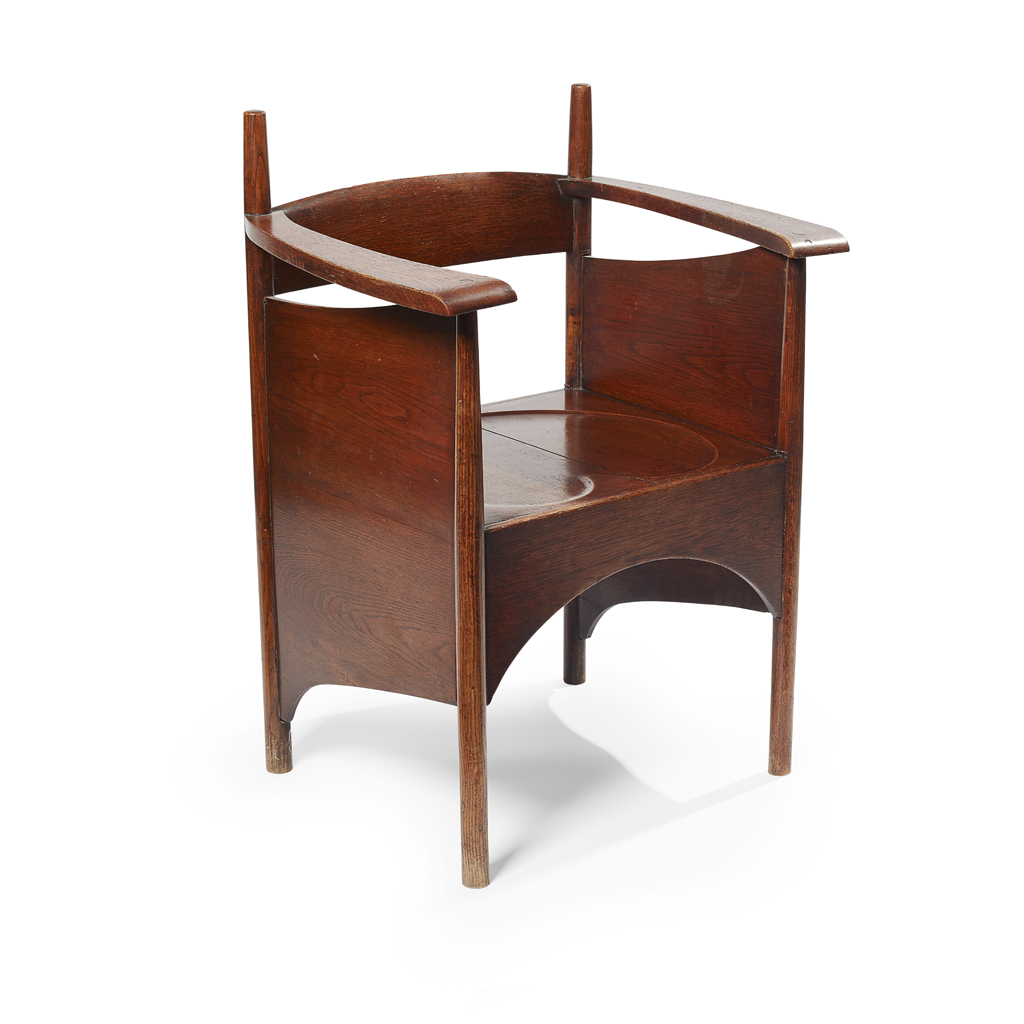CHARLES RENNIE MACKINTOSH (1968-1928) FOR MISS CRANSTON'S ARGYLE STREET TEA ROOMS, GLASGOW
STAINED OAK ARMCHAIR, 1898
£60,000
Auction: 31 October 2018 at 11:00 GMT
Description
the slightly arched top rail above curved arms and panelled sides enclosing a moulded seat and supported on turned and tapering uprights
Dimensions
62.5cm wide, 83.4cm high, 47cm deep
Footnote
Provenance: William Smith Esq., Glasgow
Literature: Billcliffe, Roger. Charles Rennie Mackintosh: The Complete Furniture, Furniture Drawings & Interior Designs. pp 10-12, 56-58., illustrations 1898.28 & 1898.30
Howarth, Thomas. Charles Rennie Mackintosh: The Modern Movement. pp 121-128
Note: In 1898, early in the career of renowned Scottish architect Charles Rennie Mackintosh (1868-1928), entrepreneur Catherine Cranston - known simply as Miss Cranston - commissioned him to furnish her new rooms at her tearooms on Argyle Street, Glasgow. Miss Cranston was to be an important patron for the young architect, who came to rely on a relatively small number of patrons throughout his career. The commission afforded Mackintosh a new freedom to experiment, whilst leading to further projects, including the Ingram Street Tea Rooms (1900) and the Willow Tea Rooms (1903)
The work at Argyle Street followed on from his previous work at Miss Cranston's new Buchannan Street Tea Rooms, which had been conceived two years earlier in 1896, together with designer George Walton. In this new undertaking, however, Mackintosh found himself in a role reversal, being fully in charge of the furnishings whilst Walton was preoccupied with designing the interiors.
The furniture Mackintosh designed for these new rooms exhibit a new, more robust evolution of his repertoire and established a style for much of his work up to 1900. The bold and simple aesthetic of the designs marked him out from his contemporaries, and the distinctive furniture he produced were also employed by him, for the first time, to define and separate the rooms as designed by Walton.
These armchairs were designed for the men's Billiards and Smoking Rooms, which occupied the building's top two floors above the tea and luncheon rooms. The tearooms were a haven from the city for both men and women, however the Smoking and Billiards Rooms were purely a masculine domain and the design and construction of the furniture is a reflection of that fact.
Combining English Arts & Crafts and Scottish vernacular design, Mackintosh produced three types of sturdy and generous seating for these rooms; a prominent ladderback armchair, its long, rectangular back rail adorned with ascending wooden slats; a cube shaped tub chair, the current example, which was a version of this chair without the tall back; and a stool, only seen in the Smoking Room from contemporary photographs. All of the furniture was either clear-varnished or dark-stained and waxed. The construction of the tub chair is traditional but the form anything but. The broad panels of sawn timber are stripped of decoration and the solid box shape is lightened with curved aprons and subtle detailing under the arms and back. Gently curved and moulded timbers to the arms and back and the distinctive tapering uprights on the angles demarcate the chair's compact, box-like composition. These details are repeated throughout the rooms, creating a balanced composition of expressive lines and simple organic shapes.
The Argyle Tea Rooms closed in 1920, and much of the furniture was dispersed. These armchairs came into the possession of established Glasgow restaurateur William Smith, whose daughter passed them on to the current owner as a gift. The robust construction of these chairs has helped them withstand many years of use, however it is their beautiful and functional design, anticipating the 20th century's Modernist ethos, which has stood the test of time.

